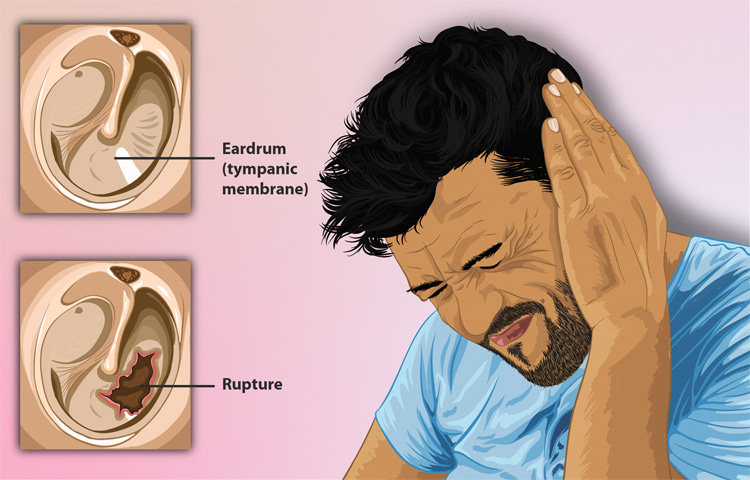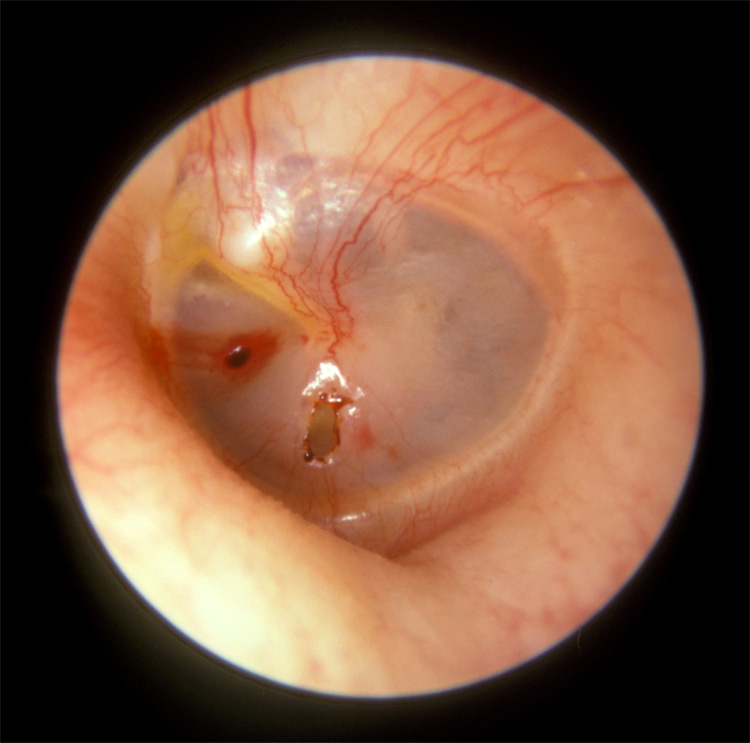What is a ruptured eardrum? How do you know if you perforate your eardrum? Can you fix or heal it?
The eardrum, scientifically known as the tympanic membrane, is a thin structure that forms an airtight seal to separate the outer ear canal from the middle ear space.
As the vibration of sound travels down the ear canal, the eardrum vibrates, transferring the mechanical vibration of sound through the middle ear bones into the cochlea.
The cochlea is a hollow bone where a sound is converted into nerve impulses and sent up to the brain.
The eardrum itself is composed of three very thin layers of tissue - the outer cutaneous layer, the middle fibrous layer, and the outer mucosal layer.
All three layers combine to be only about 0.1 millimeters in thickness, roughly the diameter of a single strand of human hair.
This explains why the eardrum is extremely easy to damage.
When damage occurs, it can cause an immense amount of pain, leave you with conductive hearing loss, and possibly requires surgery to treat.

Known Causes
A rupture in the eardrum creates an unintentional perforation or a hole.
It can result from significant fluid buildup in the middle ear space, substantial changes in barometric pressure, acoustic trauma, foreign objects, or severe head trauma.
When we think about fluid in the middle ear, we often think of the water that gets into the ear canal after showering or after swimming or surfing.
But this is not the same type of fluid. This is a fluid that actually builds up behind the eardrum in the middle ear space.
If there is significant fluid buildup behind your eardrum in that middle ear space, like someone would experience with otitis media - which is a middle ear infection - if you get enough fluid buildup behind there, it could actually cause your eardrum to burst, much like poking a needle into a balloon.
Extreme changes in air pressure can also cause your eardrum to rupture.
Humans are equipped with a eustachian tube, a channel that connects our throat to the middle ear space.
The eustachian tube's role is to regulate the pressure inside the middle ear and ensure that it is equal to the ambient air pressure outside of your ear.
You may notice this regulation when you feel your ears pop when flying in an airplane - that's your eustachian tube allowing air in and out of that middle ear space.
However, if you have sinus congestion or your eustachian tube is not opening and closing like it normally should, you could build up a significant amount of pressure that can cause that eardrum to rupture.
Loud sounds can also cause a ruptured eardrum - for example, the exposition to an explosion or a really loud gunshot.
Sound is typically measured in sound pressure level, meaning that it actually creates a pressure change.
And when you have an extreme pressure change like you would experience with an explosion or a deafening gunshot, it can actually create so much pressure that it ruptures your eardrum.
A perforated eardrum can also be caused by external objects.
A cotton swab will always be a foreign object to your ear canal.
When you take one and stick it inside of your ear canal, not only are you pushing wax further inside of your ear, but you also run the risk of rupturing your eardrum, causing extreme pain and potentially dislodging the three middle ear bones.
So, keep cotton swabs, bobby pins, car keys, or anything smaller than your elbow outside your ear canals.
Otherwise, you'll have an appointment with a surgeon in no time.
A severe head trauma - like being in a car accident - can also cause a rupture of your eardrum, structural damage to the three middle ear bones, and even your cochlea, which can dramatically impact how well you can hear.
There are also situations where a ruptured eardrum is intentional.
For instance, when an otorhinolaryngologist creates a perforation inside your eardrum to drain fluid outside of your middle ear space and then puts a pressure equalization tube in place.
This occurs mostly with children, but there are also transtympanic injections designed for individuals who suddenly lose hearing in one ear.
In this case, doctors go in and perforate the eardrum to inject a steroid into the middle ear space.

Signs and Symptoms
How does someone actually tell if they have a perforated eardrum?
The signs and symptoms of even a slight eardrum injury are almost immediate - it hurts.
You may also experience hearing loss and tinnitus.
The tympanic membrane has many nerve endings, so a subtle shift in air pressure, water pressure, or temperature will trigger pain.
You can also notice reflexive flooding of thick mucus into the back of the throat, decreased hearing, dizziness, and vertigo.
These are signs that your eardrum has likely been affected and compromised, and they can appear at any time, especially after a recent cold or viral infection.
A fully blown-out eardrum will not equalize pressure normally due to a blocked eustachian tube, resulting in pain and the inability to stand up, walk, and sit without assistance.
So, if you're unsure about the pain, try to click your ears like you would to equalize pressure in an airplane.
If the injured ear doesn't click, you could have a problem.
And if you blow against a closed nose and there's air being blown out, then you should immediately visit a doctor.
A rupture is most easily identified by a comprehensive hearing evaluation combined with visualization of the eardrum itself and tympanometry, an examination that tests the mobility of the eardrum and the ear canal volume.
Treatment and Healing
Treatment for a ruptured eardrum can be as simple as waiting to see if the perforation heals itself over the course of several weeks.
Antibiotic drops may be prescribed, and doctors will pack your ear canal with gauze to keep it dry for two months.
If a perforated eardrum doesn't heal by itself, you may need surgery - immediate surgery results in a recovery period of around two weeks.
If you have a small perforation, you may undergo a myringoplasty.
A myringoplasty is a surgery performed to patch and repair the hole with a gel-like substance or a paper-like tissue.
If you have a larger and more severe perforation, you may require a tympanoplasty.
A tympanoplasty is a surgical operation performed to remove a portion of a vein or the outer sheath of a muscle, make an incision behind your ear, pull that ear forward to get behind the eardrum, and then perform a graft of that material on the backside of your eardrum.
If the damage was caused to your three middle ear bones, you might also have to go through an ossiculoplasty.
An ossiculoplasty is the reconstruction of the three middle ear bones or the replacement with a prosthetic.

Perforated Eardrum in Surfing
The ears are the surfer's Achilles heel.
Many wave riders will develop Surfer's Ear (exostosis) and/or a perforate of their eardrum throughout their lives.
They often break their eardrum after crashing violently against the water while trying to paddle against a wave, kick out through the lip, or after an uncontrolled wipeout.
It's a frequent injury in high surf environments and big wave surfing competitions, especially in closeout conditions.
It's quite rare, but surfers can also rupture an eardrum during sudden shifts in water pressure, for example, when duck diving a bigger wave.
People who have already developed an advanced stage of exostosis have an increased probability of suffering a perforated eardrum.
This happens because exostosis changes the recoil elasticity of the ear canal, allowing more force to directly impact the eardrum.
If it occurs while you're out in the water, call for help or try to paddle in, keeping your head above the water's surface.
